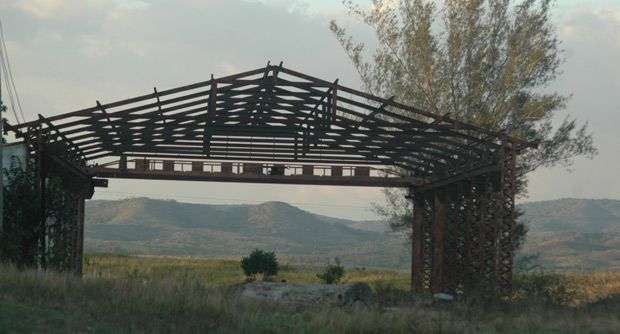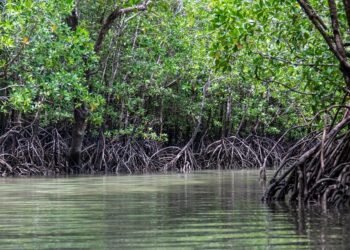“Today before dawn, I went up to the hills,
I looked at the skies humming with fireflies
and said to my spirit: When we know
all these worlds and the pleasure and wisdom
of everything they contain,
Will we be calm and satisfied?
And my spirit said, No,
We will only have reached those heights in order to carry on.”
Walt Whitman
If you are already up there, climbing up there, then you have to walk through the Escambray; up and down a hill, rest on the roadside, take some water and continue , see how the sun there is such a sun and the cold of 3.00 p.m. is so cold, and grab a bag and go on, ask where something is, try the mountain cocoa which tastes like Spanish lime, fight against very black mosquitoes and keep going. If you by chance find a girl, a man of many merits and a bad leg, and go 270 meters underground, then you’ve walked a considerable part. But do not get surprised of the merits of the man, nor when knowing the girl did not know the sea, or that someone had electricity at sixty. You should go up to El Escambray if you almost do not wonder of life.
*********
The girl is Yiliana Galvez. I do not know now what happened to her, because it’s already been less than a year, although it seems that nothing can happen in that time in the Escambray. You may go there any day of a month, and then return next year, and trees continue providing the same shade , and coffee is being planted from May to August, and the bus of 6:30 p.m. is making the journey from Santa Clara to Cumanayagua. I do not know now if Yiliana Galvez went to see the sea.
I asked her if she knew the theater, and she said she did not know the sea. I should suppose she was ignoring my question because her answer was elementary. If she had not ever seen the sea , she did not have to know the theater. That was what I drew from her words. She has been, however, many times in the river. If you analyze, people in the mountains do not have to necessarily know the sea, as coastal villages people do not have to know the river. They are locat ed in their respective places to learn a lot from these sites and know them well, so that the ones from the mountain to know the place where is located the cornerstone from where the stream births , and those from the coast to learn to barefoot walk over sharp reefs. This is the way it should be if we follow the natural destinations, b ut it not so. When you have been long in the hills, you must go to smell the salt from the rocks. Yiliana Galvez had that desire soon, and if in the mountains a nine-years old girl looks at you closely and tells you she does not know the sea, that she goes to church on Sunday and does not know the sea, that his dad is drunk and she does not know the sea, the only thing you can do is forgetting the face of the girl not to suffer a bit, but it is not easy .
Yiliana Galvez lives in El Rincon and when I met her, she had long fingernails, very long for her age. She said that her father is called Carlitos the Rat. Nobody is called like that, but I do not tell her that. She is blonde and has screaming eyes, and likes accompanying her mother to fill bags of coffee that are very well paid. She loves that, but she does not like her father to be a drunk, she does not like either she was transferred to another school, nor living so far from the beach.
I have no many answers for YiIiana’s questions , a girl I met near El Algarrobo, the farm of a coffee producer. If you see a girl in the Escambray, you do not know what to do then. Do you love your dad? I ask her and she answers affirmatively. Why did you change the school? And she said that Fernando Cuesta Piloto School closed because there were very few children, she and two or three more, who received classes of first, second , third and fourth grades by the same teacher, so she was sent to take classes to Martires de Chile School. What about the beach? She responds he has never been there, she has gone much to the river but never to the beach , no one has taken her there and she adds she loves fishing and playing marbles.
The girl has something that scares. She is always near me . She looks when I’m tak ing a photo, when taking out the recorder to interview. She listens to the interview, walks if I walk. Surely I won’t see Yiliana Galvez again. The Escambray is large and you can only remember the faces. Visitors up there rarely remember someone’s face. You might not see ever the person who filled your water bottle, or the one that gave you guavas, or who guided you to the place you were looking for. I think is better if I not see Yiliana Galvez any more . I feel afraid of children who stay quiet when listening to an interview from the beginning to the end, and I’m scared of nine years old children who want, above all, seeing the sea. I would not know what to do if I see her, fully grown, and she tells me she still has not seen the waves and the sand of the shore. I really would not know what to do.
************
Nivaldo Pérez Suárez, maintenance planner of Hanabanilla hydroelectric , told me his parents finally had light in La Jutía town after a long time had passed and when they were sixty-odd years and their son (him) was already a man. He could see, as very few people could- the river water passing to the turbine, and from there to the generator, and then it was converted into electrical energy when there was not still cold water at his home.
The Escambray, looked obliquely and from the distance, is a succession of mountains , some higher than others, so that you get to imagine you are in any low place of Cuba. In those mountains abound trees, fields of coffee and tobacco, and a very large highway. This is the first Escambray, the Escambray of those coming with a knapsack and ready to climb it without having ever done it, and they place at the beginning of the road and look away because they want to see where it goes. The Escambray, after that look, does not seem to contain much more, does not seem containing anything breaking with the perfection and harmony of the countryside, nothing located between the hills and that is made up of machines of diverse origin. For example, a hydroelectric plant, a contraption of that type placed in the middle of the landscape. But it is there and previously, a couple of hours before getting on the railway and prepare ourselves to descend 270 meters underground, and knowing also that the largest water reservoir of the country is in the Escambray and that it would be above us after a while, Nivaldo Pérez Suárez, who has worked for 31 years in the company, said that work started to be built in 1952 by the Americans, it was actually opened on January 11, 1963 when Che was the Minister of Industry and once came to the Escambray and boosted its completion and then our technicians, along with Czech technicians began assembling the first two machines .
The workers of Hanabanilla hydroelectric -a total of 72 persons-are people who speak little, hear few too, but work a lot. It is really hard working 270 meters underground and between the noises from those machines. The descent to the hydro lasts six minutes through a steep slope from which the railroad descends. You need to protect yourself wearing a helmet; no one knows what can happen. Down there is the company personnel, and there is also too much noise there, you can barely hear if someone talks to you, each one does his work, the walls sweat and cell phones lose signal there. There are machines of Czech, German and Italian origin. The hydroelectric plant generates 43 megawatts / hour and is truly incredible. It feeds from Hanabanilla reservoir, which is in turn formed by four dams with a capacity of 285 million cubic meters of water. According to Nivaldo, “the plant consumes 21 cubic meters of water per second and the best thing is that it is in the middle of Cuba, that is, it can both transmit energy to the West and East and it operates 24 hours a day. It is also a great saving for the country, because it only needs enough water and the oil that is used to start it up is minimal “.
There is the company, well hidden as not to be much noticed between the hills, with a huge lake above it, and also trees, and tobacco and coffee plantings. It seems there is not a hydroelectric plant in the Escambray. It seems, if we follow the data and tables, there are not, for example, 8382 homes, 38 medical offices, 20,071 people who live there or that there are also sales kiosks, public transportation and movie theaters. By far, it seems not be none of this there.
Nivaldo Pérez Suárez told me he remembers the day electric light came, 14 years ago, to La Jutía town. The electric company workers finished installing the poles and wires late at night, but at that hour his parents and all residents of La Jutía danced and laughed and were happy as never before. Nivaldo says that when they had no light and her mother cooked with wood, they had fewer problems, and adds that today, when there is no electricity, his mom quarrels a lot because she can not cook. So things are. Nivaldo had not tasted cold water as a boy and now he has done it, but it is said in the Escambray that at-room-temperature fresh water, well and stream water, is what really quenches thirst.
*********
Morffi knows that this story is not as told, no, sir. He is Alberto Gonzalez Morffi and knows that Manuel Ascunce and Pedro Lantigua, teacher and student, were not hung from a Flamboyan tree. Things do not have to follow confusing. When that day of November 1961, Morffi helped putting down the bodies from the tree, the hanging bodies of Manuel Ascunce and Pedro Lantigua, he noticed two important things: one, bandits made Lantigua a mooring in his genitals with a thorny plant, the other was that both bodies had been stabbed with a bayonet, they were terribly riddled, and finally that these men were hanged from the rough and winding branches of a tree popularly known as ¨Bienvestido¨, and not from a Flamboyán tree.
When Morffi was fifteen, he was in a hospital bed in the city of Cienfuegos with three shots in his chest, one in the arm and another in the leg. Among several reasons, Morffi was there because two years earlier he was felt himself terribly bored. You can be bored at twenty-something, and at any age that happens next, but no one at thirteen can carry the weight of tediousness. “My father was very hard with me and to take me off the yoke I went to the Escambray Cleaning”. That is what Morffi told, who fought against bandits in the hills, who took the bus like me, who got off where I did, who talked to me.
Morffi takes harshness in his body. He has big hands, wide neck, and thick trunk. However, the arched contour of his eyes is not part of that physical roughness. People are almost always as their eyes say. Bright eyes belong to bright people, elusive eyes are common in distrustful people, faded eyes are related to sad people, and the shining ones belong to happy people. Morffi´s arched eyes, arched and fixed and somewhat distressed, reveal now that Morffi wants to say something. Morffi was making stories on the bus that departed from Santa Clara towards the Escambray, and then he continued talking when he got off where you have to stay to go to the town of La Yaya, and after a while he knew that I was making interviews and he told me there were important people in La Yaya: artists from the Escambray group, a dancer who has traveled to foreign countries, and a baseball player whom he does not remember the name but who participated in the National Series.
Morffi lives in Jorobada, to six kilometers of La Yaya. He lives with his wife. Morffi undoubtedly wants to talk. He told me of the fight against bandits, and about important people, and soon he states: “My house is in very bad shape, and I live with two grandchildren and my wife.” After this, I am ashamed to carry the recorder in one hand, the agenda in the other, and a bag on my shoulder, those things for which people think that you can help them in something, or get them out of the mess. He tells me that his house is in very bad shape and he has made 130 blood donations; that the walls of his house are falling down and he has been involved in more than 10 sugarcane harvests and he has also worked for 40 years in the sugar industry; he adds he lives in that appalling conditions and has the Jesus Suarez Gayol medal, who died in Bolivia with Che; he states he is living in that way with his family and also has the Medal of Valor, which was granted to him for a magazine that he put the fire out in San Antonio de los Baños village.
I still carry the recorder in one hand, the book in the other and a bag on my shoulder. I went to the Escambray to ask about artists and I find Morffi and I almost cynically could only tell him: Do you like theater?










